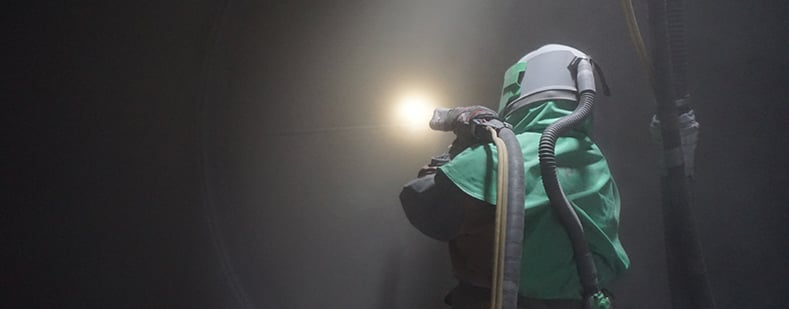Contractors and facility managers alike agree that worker safety is the top priority when working on abrasive blasting job sites. From the depths of underground utility vaults to the interior of storage tanks, examples of confined spaces abound. Found in a wide range of industries and workplaces, each pose a unique risk to those who must enter them.
Unfortunately, while access for humans can be difficult, corrosion has no problem getting into the tightest areas. Blasting these surfaces and applying protective coatings can be quite challenging, but with the proper safety considerations, the job can be done.
Before working within confined space, it's essential to work with your company's health and safety personnel. Additionally, local, state, and federal laws must always be followed when working within hazardous environments such as confined space. Following your company's rules on confined space can be a matter of life and death.
Below we look at information from OSHA and the U.S. Department of Labor, major governing bodies for worker safety in the United States.
What is a confined space?
According to OSHA, a space is considered a "confined space" when it is large enough for workers to perform certain jobs in (such as blasting or coating), but the area was not necessarily designed for humans to be in. Confined spaces often are not designed for “continuous occupancy” (OSHA) and have inadequate or complex means for entry and exit.
These confined spaces are areas in which workers spend multiple hours - sometimes even the entirety of their day - working in. They include places like tanks, pipelines, cofferdams, and vessels, amongst many others.
Under the umbrella of general confined spaces, there are also what OSHA calls, “permit-required confined spaces.” This type of confined space is determined through an extensive evaluation of the area in order to determine the magnitude of risks present. OSHA states that if a confined space has one or more of the following characteristics, it is considered a “permit-required confined space”:
- Either contains or at any time has the potential to contain a hazardous atmosphere, such toxic gas or flammable substances
- Encompasses material that has the potential to engulf an entrant, such a liquids or flowable solids
- Has walls or floors that converge inward or slope downward, tapering into a smaller are in which the worker can become trapped or asphyxiated
- Possesses any other recognized health or safety hazard (ex. unguarded machinery, exposed live wires, heat stress, etc.)
According to OSHA, in the United States alone, more than 4.8 million confined space entries are made per year.
Abrasive Blasting Inside of Confined Space
Because going into and out of confined space regularly can be a challenge, it's important to prep surfaces and apply paint correctly the first time. Touchup work and recoating cannot be done "on the fly" and must be coordinated with company Health and Safety departments.
Sponge Blasting surfaces inside of confined spaces will ensure the highest quality surface preparation prior to recoating. Confined spaces such as tanks must be regularly inspected at scheduled times. If coatings inspectors identify failed coatings, they may require the whole space to undergo a coatings removal and recoat. This can mean downtime for the asset, which can translate to thousands of dollars a day in environments such as oil refineries.
Sponge Blasting also creates a low dust, low rebound environment which is essential for the protection of laborers working inside these confined spaces.
In recent years, the emergence of robotics for surface preparation inside confined space has been utilized. Sponge-Jet's Robotica has been used to prep miles of pipeline, and thousands of rail industry tank cars.








